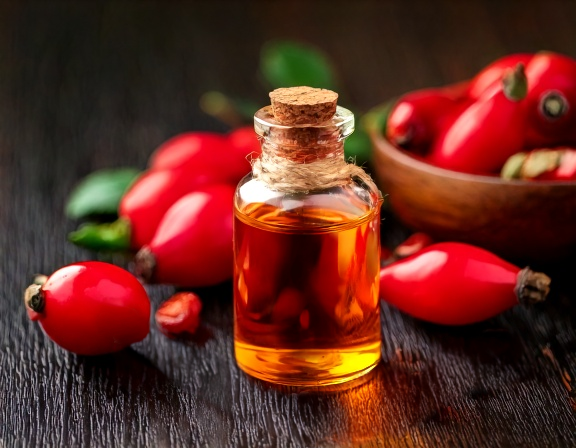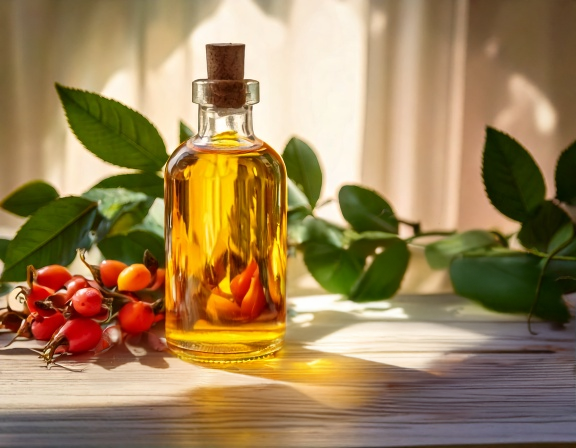Rosehip Seed Oil Benefits: Garden to Anti-Aging Serum for Radiant Skin – How to Use & DIY Recipes
From the rose bush to your bathroom shelf—discover how rosehip seed oil supports smoother tone, softer lines, and a naturally luminous complexion. Grow, harvest, blend, and use it like a pro.

Skin Glow Blueprint
Your step-by-step weekly plan for brighter tone and smoother texture—how to pair rosehip oil with cleansing, gentle exfoliation, and sun-smart habits.
Get the blueprintRosehip seed oil is one of nature’s most elegant solutions for healthy-looking skin. Pressed from the tiny seeds inside the fruit of wild and garden roses, this lightweight oil glides on, absorbs quickly, and leaves a soft, non-greasy finish. Fans love it for easing the appearance of fine lines, supporting even tone after breakouts or sun exposure, and restoring a fresh, dewy glow. If you garden, you can even grow your own hip-bearing roses for the full garden-to-bottle experience.


Why rosehip works (and safety)
What makes rosehip seed oil special? Its balanced profile of essential fatty acids—especially linoleic and alpha-linolenic acids—helps support the skin barrier for a smoother, more supple feel. Naturally occurring antioxidants (tocopherols/vitamin E and carotenoids) and small amounts of trans-retinoic acid (a vitamin A derivative) are often credited with the oil’s “brighten and smooth” reputation. Many people notice a softening of fine lines, improved glow, and a more even-looking tone with consistent use.
For plant background and taxonomy, see Kew Science on Rosa canina. Dermatology resources like DermNet and evidence roundups on PubMed provide context on rosehip oil, vitamin A relatives, and fatty acids in barrier repair.
Kew: Rosa canina DermNet: Rosehip oil PubMed: Rosehip oil
Good to know
- Patch test first: Apply a drop to the inner forearm for 24 hours.
- Sun care: Use SPF daily—glow looks best when protected.
- Sensitive eyes: Keep oil near the orbital bone, not in the eye.
- Pregnancy/Breastfeeding: Ask your clinician before using vitamin-A-rich products.
Grow & harvest rosehips for beauty
Rosehips are the fruit that forms after a rose blooms. Species and old garden varieties—especially rugosa and dog rose—are generous producers. Plant in full sun with well-drained, fertile soil. Water regularly in the first year; mature plants are fairly drought-tolerant. For a bumper hip crop, deadhead early in the season, then stop by midsummer so flowers set fruit.
When to pick
Harvest hips in late summer through fall—many gardeners prefer just after the first light frost when hips are plump and richly colored. Use gloves and pruning snips to avoid thorns. Rinse, dry, and store in the fridge if processing within a few days, or dry them for later herbal use.
From fruit to serum: how rosehip seed oil is obtained
Rosehip seed oil (what we use on the face) is cold-pressed from the tiny seeds inside the hips. Commercial pressing yields the most stable, potent oil with that signature orange-pink hue. While true seed pressing at home is difficult, you can create a gentle hip infusion by steeping dried hips in a neutral carrier (like jojoba) for several weeks, then straining—great for body oils and bath soaks.


Safety tip
When processing whole hips, scoop out the itchy inner hairs before drying or infusing. Those hairs are nature’s “itching powder.”
How to use rosehip seed oil for radiant, age-defying skin
After cleansing (and toning if you use one), apply 2–3 drops of rosehip seed oil onto slightly damp skin. Press and glide over face, neck, and chest. Layer a moisturizer on top if you’re dry; oily or combination skin types often love rosehip alone at night. In the morning, follow with sunscreen.
Layering & pairing
- With vitamin C serums: Let water-based serums absorb fully, then seal with rosehip oil.
- With retinoids: Alternate nights to start, or buffer strong retinoids with a drop of rosehip after application.
- With makeup: A micro-drop pressed into high points gives a fresh, healthy sheen.


14 Day Digestive Health Reboot
- Science-backed plant protocols for digestion and skin renewal
- Uses natural foods, probiotics, and herbs—no harsh cleanses
- Supports clear skin, regularity, and healthy gut flora in 14 days
DIY anti-aging recipes (simple & effective)
Everyday Glow Serum
- In a 1 oz / 30 ml dark glass bottle, combine 1 tbsp rosehip seed oil + 1 tsp jojoba (or squalane) + 3–4 drops vitamin E (mixed tocopherols).
- Optional aroma: 1 drop lavender or frankincense (~0.3% dilution). Skip fragrance if sensitive.
- Use 2–3 drops nightly on damp skin. Expect a softer look and dewier texture within 2–4 weeks.
Targeted Tone & Texture Spot Oil
- Mix 1 tsp rosehip seed oil with 1 tsp jojoba in a tiny roller bottle.
- Roll lightly over uneven tone or post-blemish marks nightly for 8–12 weeks.
- Pair with SPF by day. For a full scar-care playbook, see our guide below.
Soft-Focus Cleansing Oil (PM)
- Blend 2 tsp jojoba + 1 tsp rosehip seed oil.
- Massage 60–90 seconds; emulsify with warm water; remove with a damp cloth.
- Follow with your favorite gentle cleanser if you prefer a double cleanse.
Active compound spotlight
Essential fatty acids (LA & ALA) support barrier lipids; tocopherols defend against oxidative stress; carotenoids/retinoic acid (trace) help encourage a smoother, more even look over time.
This herbal recipe is shared for educational purposes only, based on traditional use and available sources. It is not medical advice. Please consult your healthcare provider before use, especially if pregnant, nursing, or on medication.
Want a calmer, brighter routine?
Get plant-powered beauty tips, seasonal DIY recipes, and dermatologist-informed guides delivered to your inbox.
Subscribe now